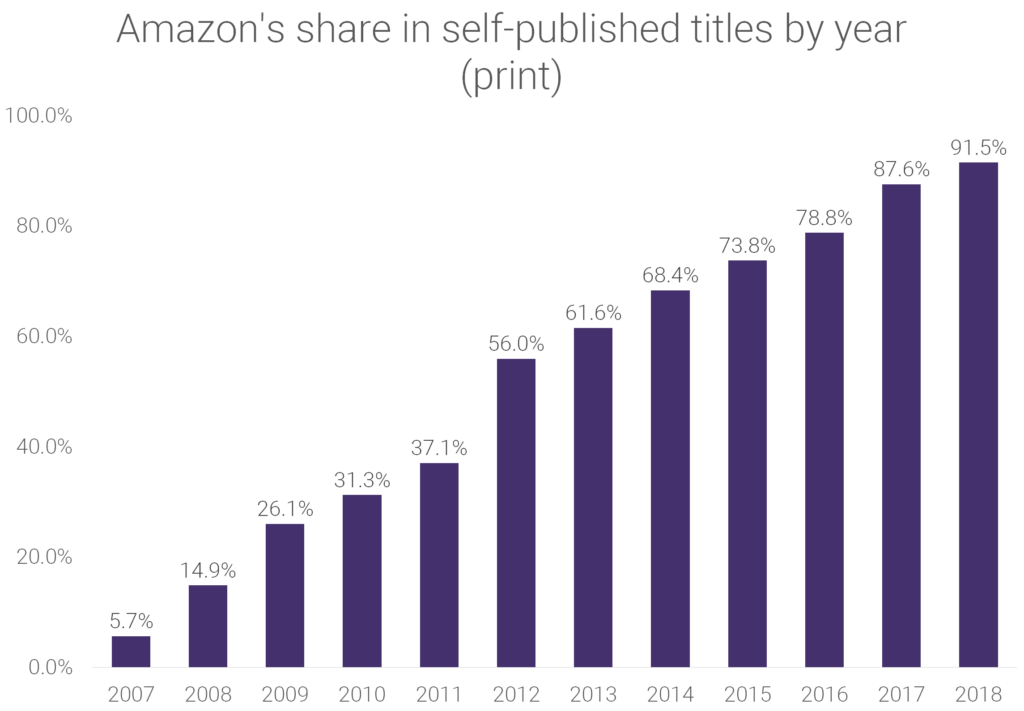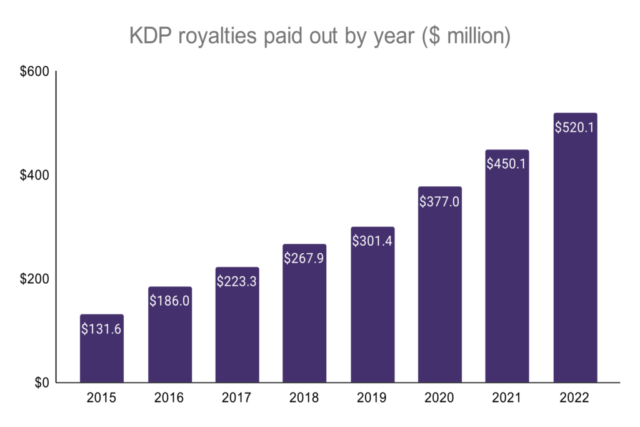From WordsRated:
Amazon was initially founded as a bookselling platform in 1995. Since then, the company has gone through massive changes, becoming the world’s biggest retail company in which bookselling represents just a fraction of profit.
However, even in the book sales sector, the company dominates the book publishing industry with an upwards trend, threatening to overtake the market in the future completely. On the other hand, the company did a lot of positive things for the book industry, such as the emergence of self-publishing accessible to anyone. In this report, we’ll cover all the aspects of Amazon’s book publishing business.
Amazon book sales
Even though Amazon’s book sales make up only 10% of the company’s profit, they are still the biggest seller of books in the United States and worldwide.
Amazon generates around $28 billion worldwide from book sales every year. The company is responsible for over 50% of sales from the Big Five publishers and controls between 50% and 80% of the book distribution in the United States.
- Amazon sells at least 300 million print books every year.
- The company reportedly controls at least 40% of the print book sales in the States.
- Some estimates show that by 2025 Amazon could take over more than 70% of the US print book market.
- In the UK, Amazon controls at least 50% of the market, selling over 106 million copies each year.
When it comes to ebooks, Amazon is dominating the market by a wide margin.
- Amazon sells over 487 million ebooks through Kindle every year.
- The company’s market share in ebook sales stands at least 67%, climbing to 83% when Kindle Unlimited is included.
- Amazon is estimated to control over 87.9% of yearly ebook sales in the UK.
- Even though the company sold more ebooks than print books in 2011, nowadays, Amazon sells 3x more print books than ebooks.
Self-publishing on Amazon

Amazon has been the driving force behind the massive emergence of self-published books in the United States:
- Amazon releases over 1.4 million self-published books through its Kindle Direct Publishing every year.
- This doesn’t even take into account self-published ebooks with no registered ISBN number, so the extent of Amazon’s self-publishing figures is much higher.
- Kindle Direct Publishing is regarded as the largest ebook publisher of self-published ebooks, even without official numbers available.
- Amazon pays over $520 million in royalties each year to over 1 million authors who decided to self-published through KDP.
- Only 1% of audiobooks on Audible are self-published
- Self-published books account for 31% of Amazon’s ebook sales
- Self-publishing authors have the option to publish their work in 40 languages.
…
Amazon’s Royalties Paid to KDP Authors

Link to the rest at WordsRated
What bothers me more than anything else is how nice and smooth a trendline that “compensation” total creates. Division revenues (as disclosed in various SEC filings by Amazon), public statements, lamenting from NYC commercial publishing, evidence submitted in various lawsuits, etc., etc., etc. uniformly do not support an approximately linear trendline… not to mention that the trendline completely ignores COVID effects.†
A quick-and-dirty calculation shows a standard straight-line linear fit of the line:
131.6 + 54*(year-2015)
from the stated data has a maximum data deviation of 13% and a mean data deviation of 5%… which is less than the mean data deviation of “later-reported-under-penalty-of-perjury corporate earnings” from “analyst predictions of corporate earnings” for S&P 500 companies from 2012 through 2020. More to the point, the correlation coefficient is astoundingly high for “real world” data.
In my first profession, we called retrospective results that looked like this this “pencil-whipping.” In fandom, it’s called “retconning.” In law, it has much darker names that sometimes end up pointing here after substantial further inquiry.
tl;dr GIGO. Drawing conclusions from bad data that appears to have been manipulated and is not subject to independent verification because the data is based on “trade secrets” is dumber than a box of rocks.
† It irritated me a great deal that “auto repair shops and parts stores” (among other places) were considered “essential,” but neither libraries nor bookstores were.
One rule of statistics is that, while usually suspect, a linear (or other simple curve) does actually represent the real data.
This one, of course, has a statistical problem in that it eliminates ~92% of the available data points by annualizing it.
Besides the fundamental issue, as well noted by Tim, that this is not Kindle Publishing royalty data, but Kindle Unlimited royalty data. The KU payout pool each month is only related to KU revenues – it is set by fiat by Amazon bean counters. Almost certainly not some simple percentage of net subscription revenues, but taking into consideration marketing issues (get more writers into KU and Amazon Exclusive, or not needing any more at this time), transfers and set-asides of current revenues into other areas and for infrastructure build-out, etc. Numbers that are subjected to user changes are the most likely to create simple relations when plotted out. (As is seen in many other, and more important, “disciplines.”)
Okay, gripe time – that took me SIX tries to prove that I’m not robotic. Sheesh!
That was fast.
I rarely get in in less than ten.
(Well, nine, anyway.)
Ultimately, that is my point here: The data provided, and upon which the OP relies (and many other commentators have relied/will rely), does not accurately reflect actual “sales” data. That’s what the data itself says. That’s what the policy behind these ‘releases” says. So relying upon it to project trends of any kind is, well, so far from credible that even Congress wouldn’t do it. (OK, maybe it would, but you get my point.)
On one thing, though, I will disagree with you: I have yet to see validated six-year based-solely-upon-the-data economic trend that closely approximated a simple linear/straight-line regression. In anything. Every time I have seen one it has resulted from retrospective massaging of data… or preprogrammed output of a multiyear plan that was independent of actual results. Neither justifies any reliance whatsoever.
I’m fascinated by this report, because after reading it, I’m intrigued to find out who WordsRated really are, what their agenda is, and how they are funded. They appear to hire people to conduct surveys, but most of their ‘research’ appears to be content farming about topics they don’t really understand. And yet their website doesn’t carry adverts, so they aren’t standard content famers.
This article on Amazon Publishing Statistics looks plausible at first glance, but there are significant errors.
Some of the juiciest data they present about Amazon are figures that Amazon doesn’t make public. But none of WordsRated’s articles have any source references other than circular references to other WordsRated pieces. This all leads me to conclude that someone without much subject matter understanding has googled some questions and presented the mix of real data, conjecture, and misunderstanding as a properly researched report. Rather like ChatGPT.
Take this claim as an example:
“Amazon pays over $520 million in royalties each year to over 1 million authors who decided to self-published [sic] through KDP.”
1. The $520m is wrong. This is the 2022 figure for Kindle Unlimited payouts for titles in Kindle Select (ie eBooks that are Amazon exclusive). The figure does not cover royalties paid for Kindle sales.
2. Confusing KDP with KU/ Kindle Select is a common misunderstanding for commentators with a shallow understanding of eBook publishing.
3. KDP encompasses more than self-publishing, but the report repeatedly implies that all KDP titles are self-published. In many genres, the Amazon bestseller charts are dominated by small presses that grew from the operations of successful self-publishing authors. Often, these still publish the original authors, but they publish other authors too.
4. Since none of the figures reference their sources, I don’t trust the ‘1 million authors self-published through KDP’ figure. Amazon has said that 100s of thousands publish through KDP [for example this article in 2019 https://www.aboutamazon.co.uk/news/innovation/kindle-a-year-in-review%5D What Amazon did say back in 2019 was that a million *titles* are available in *Kindle Unlimited* program. I think it’s more likely that WordsRated have confused the two. I could be wrong, but since WordsRated is not a trustworthy source, I think my explanation is more likely.
5. They follow the text segment with a bar chart that shows the annual Kindle Unlimited payouts since the program started in 2015. But they’ve added a title, claiming that this actually shows ‘KDP royalties’, which repeats the error they made in the text.
So what’s their game here? I can’t figure this out.
Good points, T.
I also wondered how the authors of the OP got some of their data.